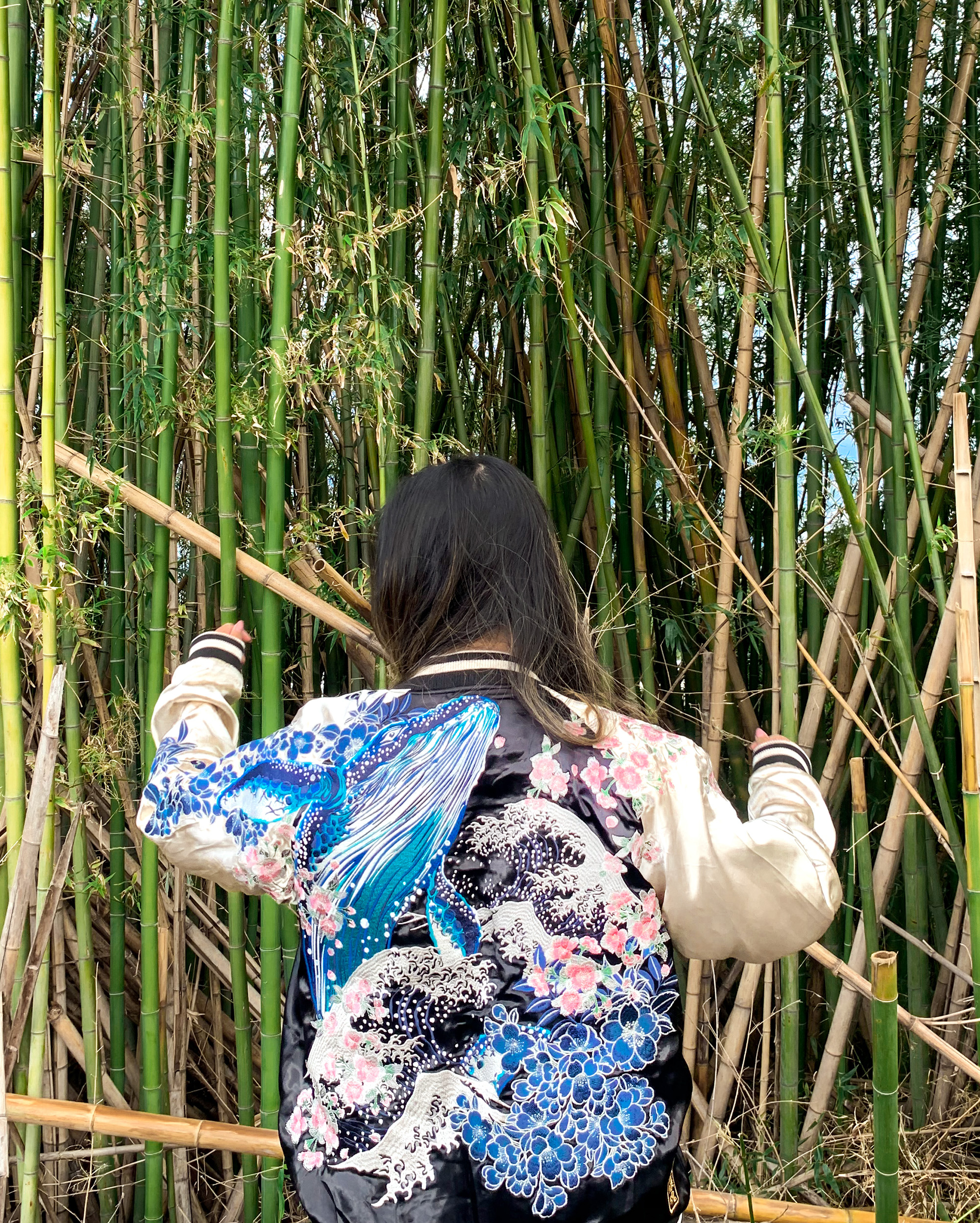
Despite being severely incapacitated by the stomach flu while a typhoon raged outside in Kyoto, I was determined to find an authentic sukajan jacket. Venturing beyond the safety of my AirBnB (and a nearby toilet), I faced the harsh elements — wild winds and whipping rain — armed with a flimsy, leopard print umbrella, an even flimsier plastic poncho and a strong will.
Trudging up to BSC Gallery in traditional Kyoto, my heart leapt in anticipation of discovering a unique, one-of-a-kind souvenir jacket that would serve as a tangible reminder of my trip to Japan. Rack after rack, I flipped through a treasure trove of outerwear masterpieces in a rainbow of fabrics emblazoned with terrifying tigers, refined geishas, delicate sakura blossoms, and goldfish that guiltily reminded me of neglected childhood pets.
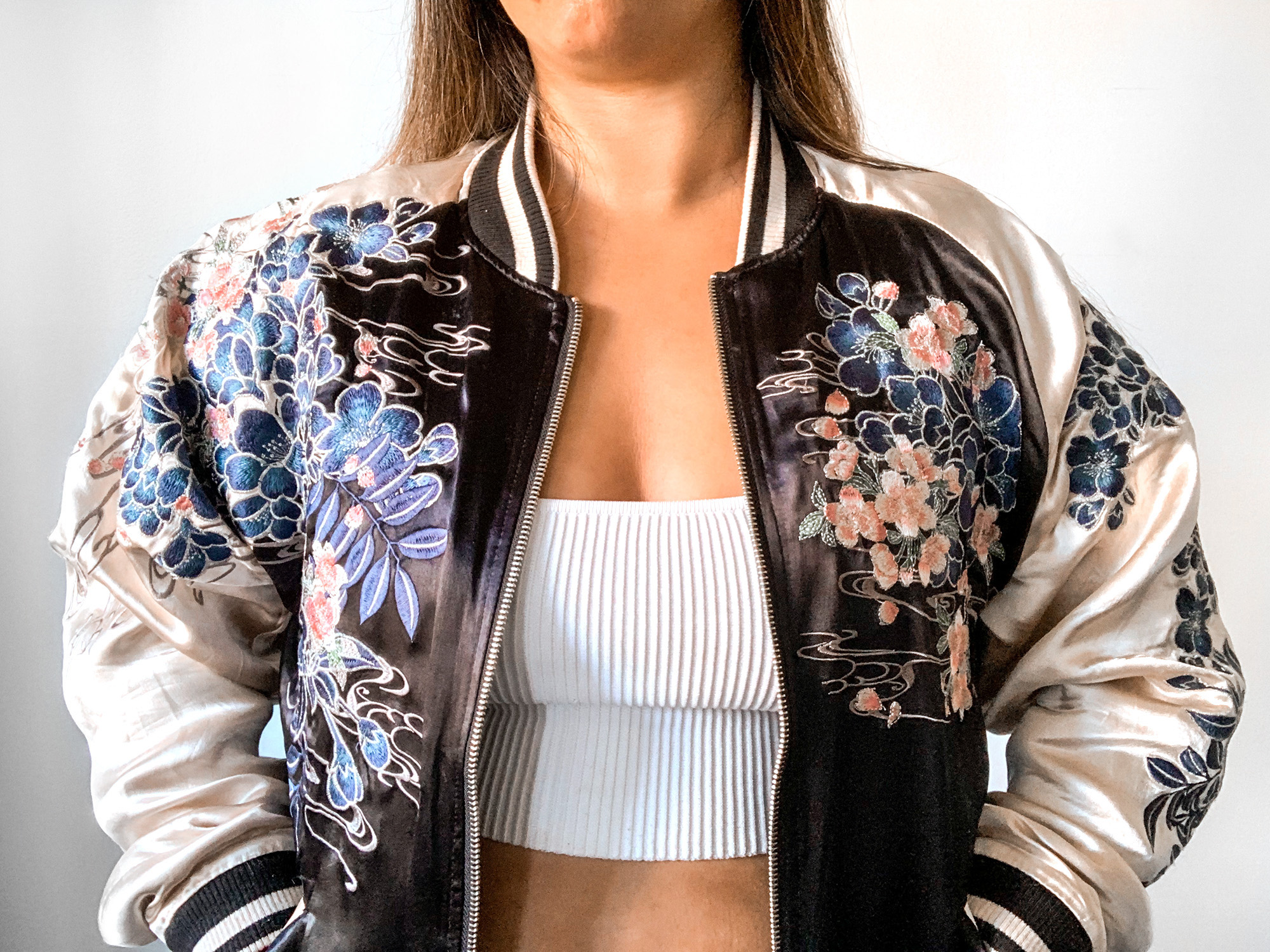
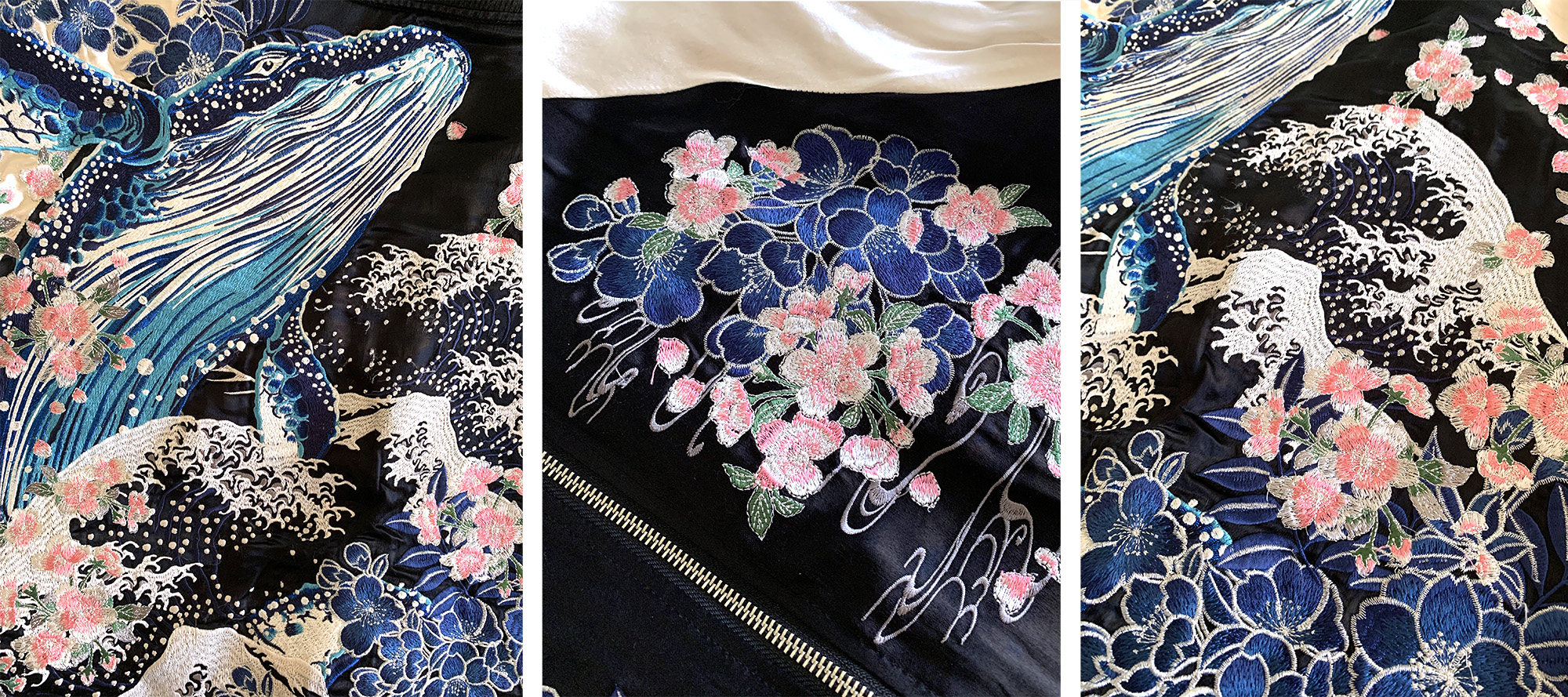
After 90 minutes of searching, I began to despair that I wouldn’t find a sukajan jacket that resonated with me. Then the shop owner pulled out the one. The glossy black silk on the body was intensely embroidered with blue and pink flowers that blossomed down gold sleeves and ran across the back that featured a majestic whale leaping from crashing waves in the infamous woodblock-style of the Japanese artist, Hokusai.
It was truly a wearable piece of art. And I had to have it. After shedding a tear upon handing over my credit card for financial abuse (that heavy embroidery doesn’t come cheap!) I was in possession of the most gorgeous garment I’ve ever owned. Even when my credit card statement arrived in the mail, I regretted nothing.
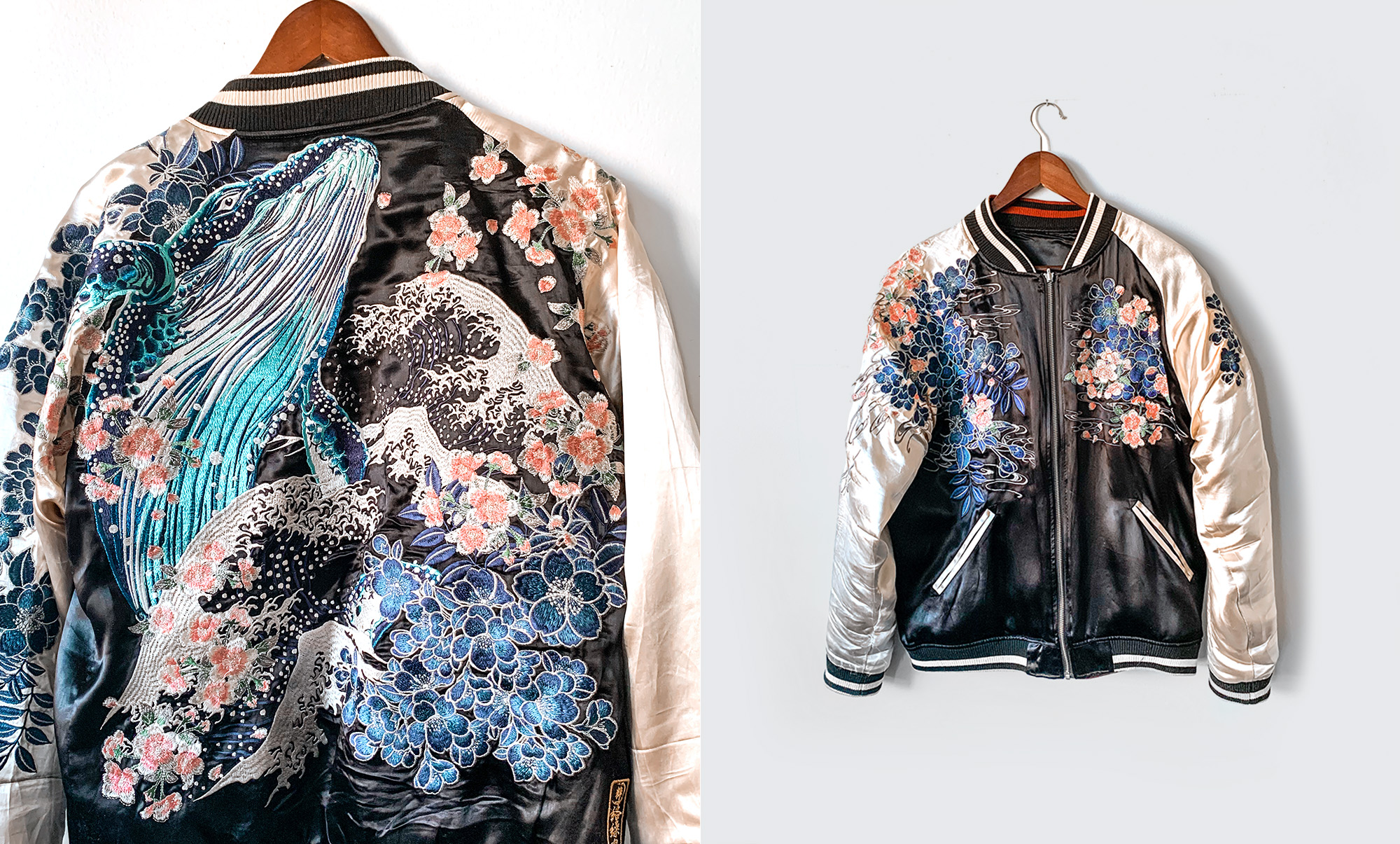
RELATED READING:
➳ How To Plan For The Most Culturally Authentic Trip To Japan
➳ Essential Tips Every First-Timer Should Know To Plan A Trip To Japan
➳ The Souks of Marrakech: Souvenirs and Haggling Tips
Japan is full of endless treasures and goodies to haul home — from handcrafted sake sets to premium knives to life-changing skin care products. There are foot masks that make your skin shed till they’re as soft as a baby, Kit Kat bars in every flavour imaginable and elegant folding fans made of durable cypress.
Yet to me, the only keepsake I was interested in was the sukajan jacket. With its deep cultural and historical roots and masterful craftsmanship, it is the ultimate Japanese souvenir. Here’s why:
History of the Sukajan Jacket
Before the sukajan became a covetable fashion piece that dominated the runways, the history of this souvenir jacket can be traced back to the end of World War II in Japan.
As the 1940s post war occupation of the naval ports in Japan came to an end, American soldiers were looking for keepsakes to memorialize their time overseas. With limited room to carry home souvenirs, soldiers sought local artisans specializing in intricate Japanese embroidery to embellish their flight jackets with personal slogans and exotic motifs of the Far East.
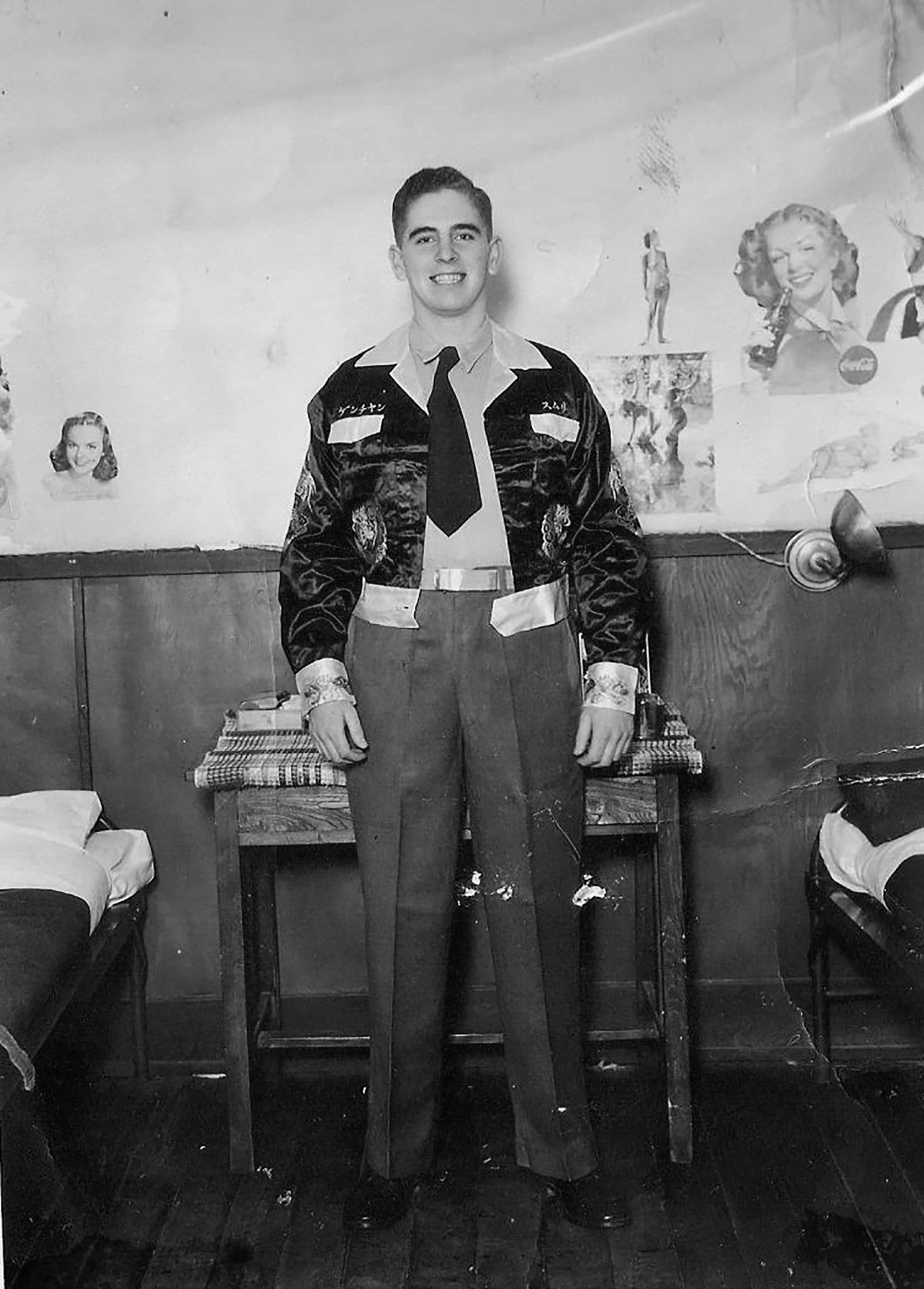
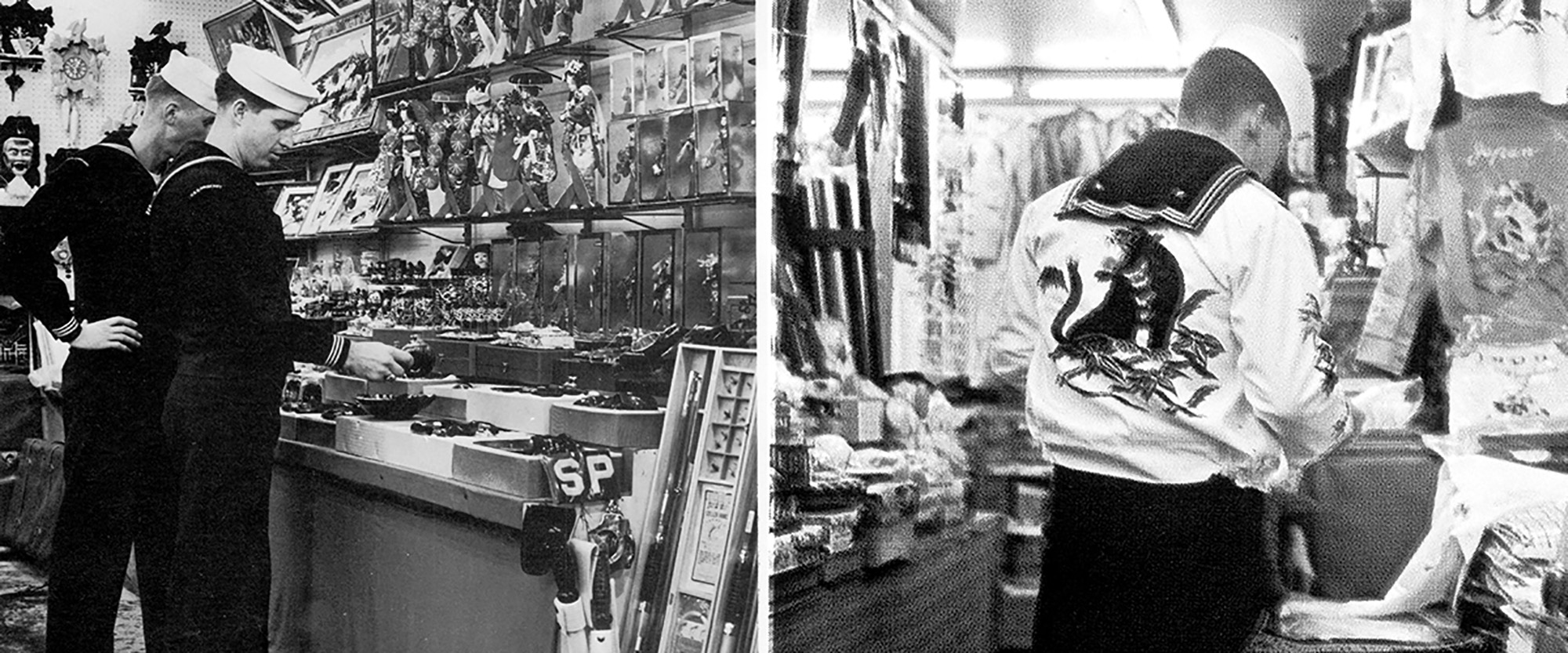
Vintage photos of American soldiers wearing and shopping for souvenir jackets. (Top photo via Japan Jacket. Bottom photos via Toyo Enterprise)
Capitalizing on this burgeoning tourism market, Toyo Enterprises (formerly Kosho & Co.) began crafting new garments inspired by popular varsity/baseball jackets using bright silk, satin and eventually leftover parachute material for fabric. The ornate designs on the back of the sukajan blended Eastern and Western symbols — eagles (for America) and everything from cherry blossoms and tigers to koi fish and geishas for Japan.
Sukajan is a Portmanteau
While writing a blog post about glamping near Toronto, I learned a new word: Portmanteau. It turns out that Sukajan, also known as Souvenir Jackets or Suka Jackets, is a blending of words as well.
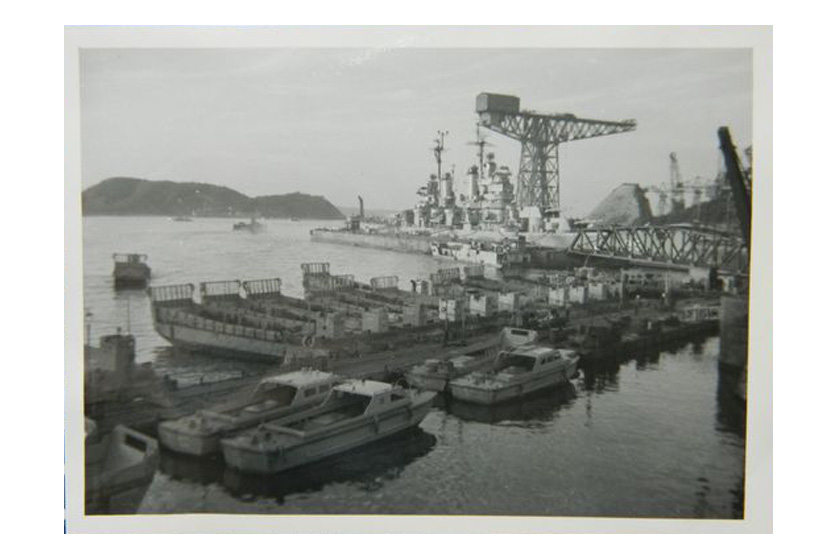
Print via Etsy of Yokosuka Japan US Naval Base Shipyard
They were originally known as Yokosuka Jumpers after the city in the Kanagawa Prefecture that it originated in. It was also home to the largest US naval base near Tokyo where thousands of American servicemen (who started the trend) were stationed. The moniker was later abbreviated to the portmanteau “sukajan” — “suka” for the base location and “jan” for the Japanese word for jumper, the style of blouse jacket.
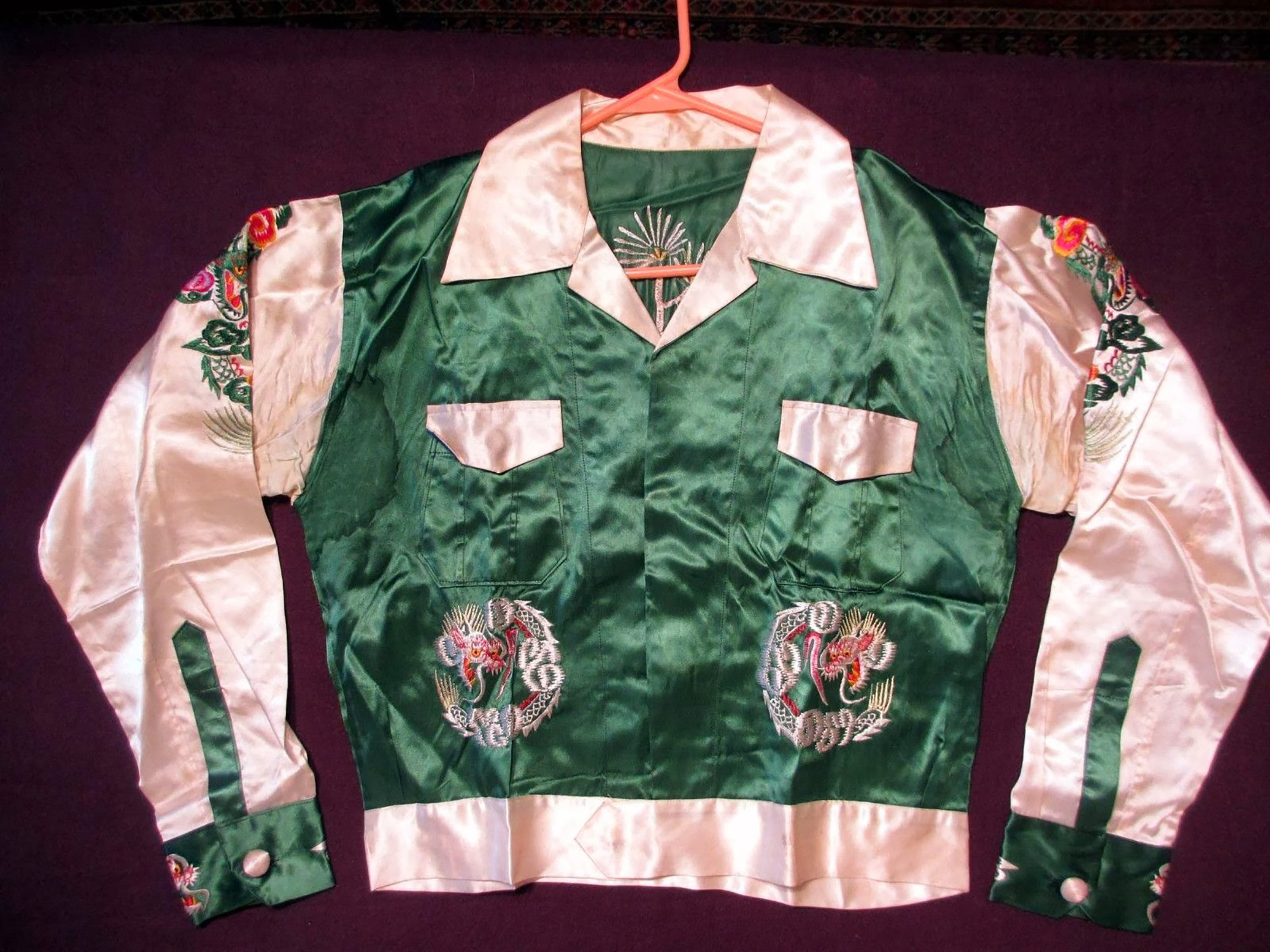
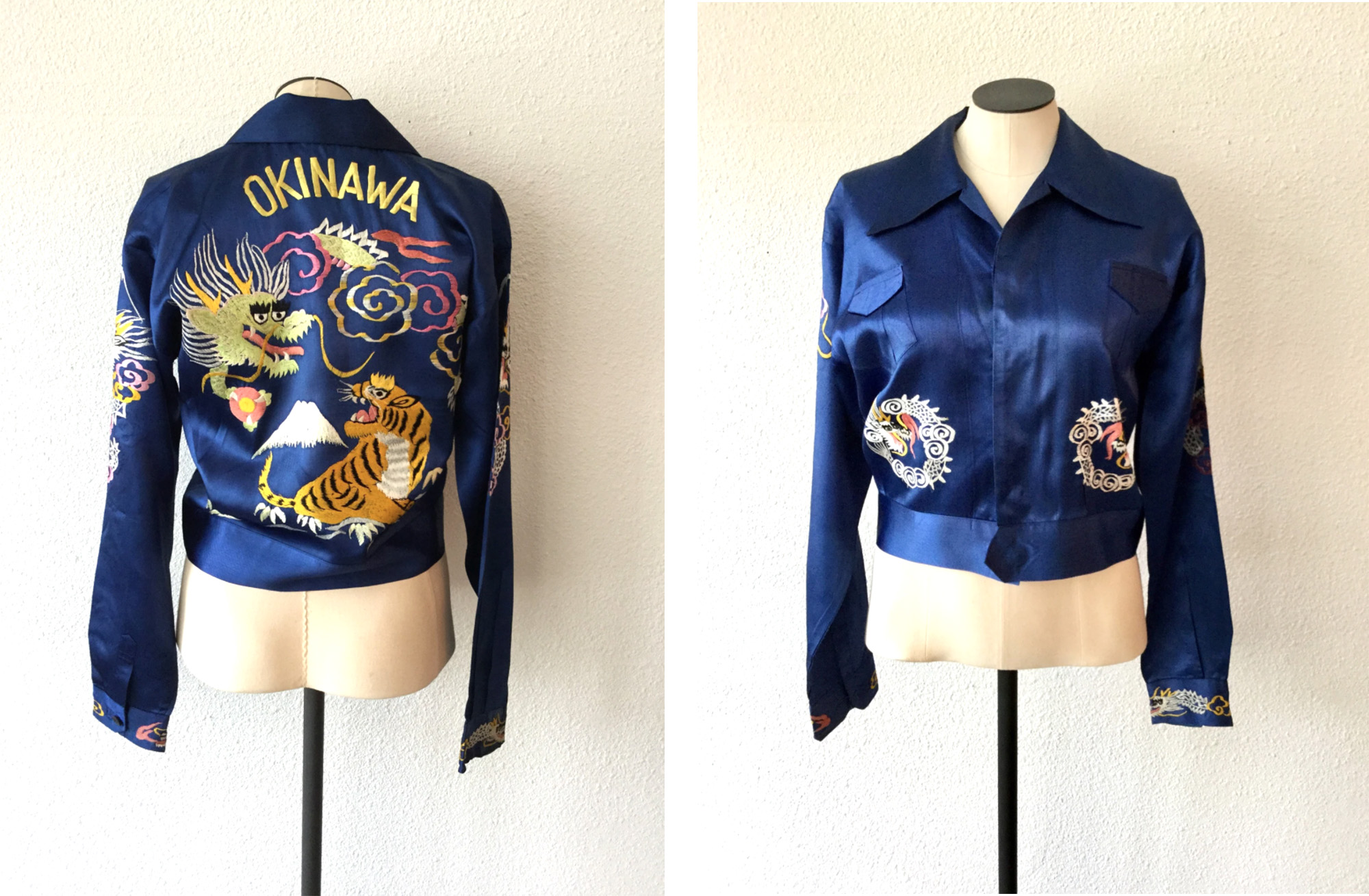
Rare Vintage 1940s WWII Japanese souvenir Sukajan satin jacket via Bee & Mason Vintage
Another theory of the name is that “sukajan” is a mix of the phrase “Sky Dragon Jumper” in Japanese…but the former explanation seems more likely to me. Plus I like having any excuse to whip out “portmanteau” from my vocabulary.
Reversible versatility
After 90 minutes of sifting through rack upon rack of vibrant sukajan, of course the one that I desperately wanted was alarmingly expensive. Wringing my hands in indecision, I rationalized that the intense embroidery and high quality of the souvenir jacket was worth the hefty price tag. But what ultimately sold it for me was that it was reversible — 2 jackets for the price of one!
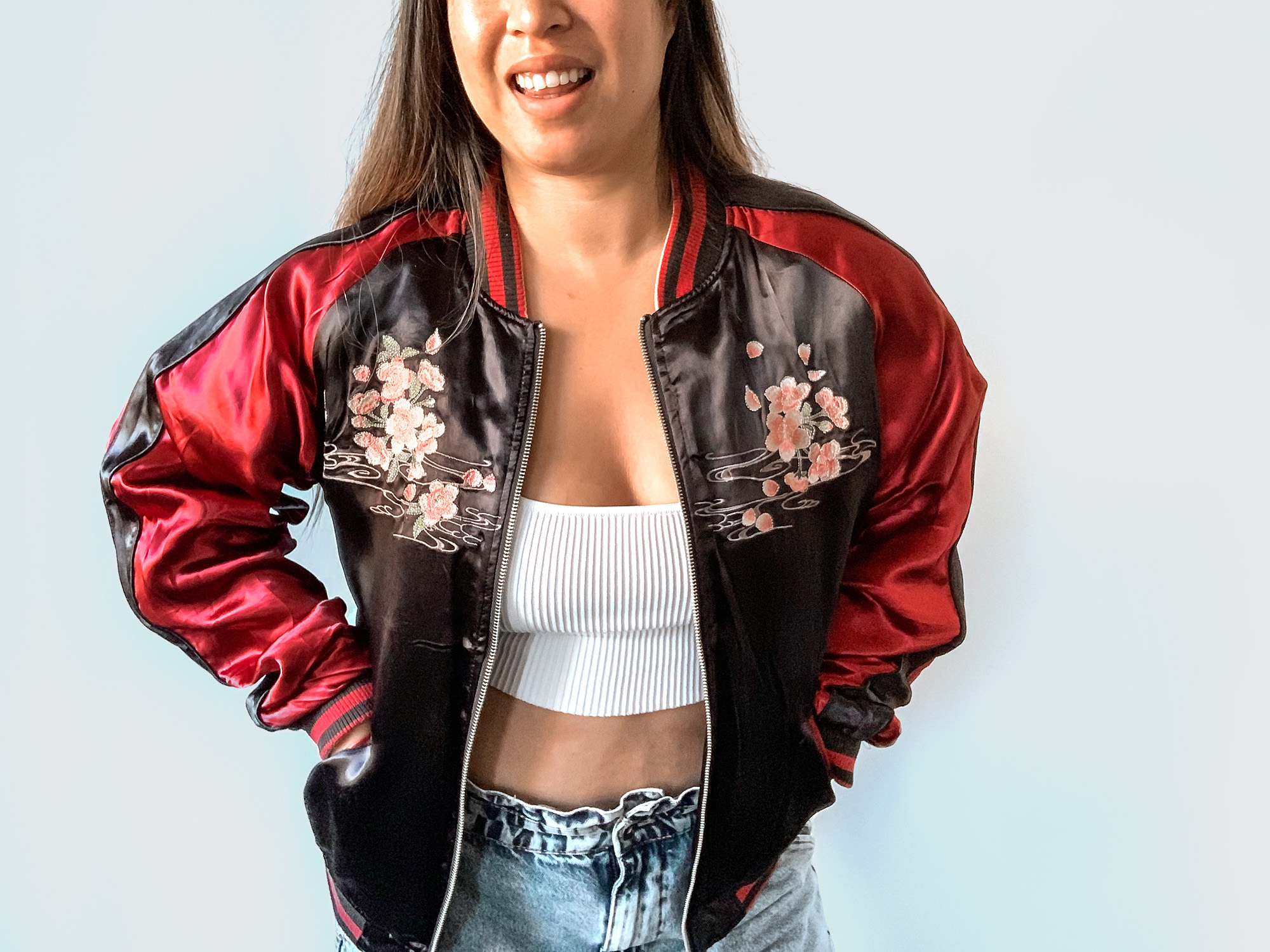
The reverse side of my sukajan
Sukajan were purposely designed to be reversible, and not just to provide the wearer with more styling options. Looking for a way to commemorate their time stationed in Japan, American soldiers sought to customize their souvenir jackets with maps of military campaigns and personal slogans.
The resulting sukajan often had a grim humour that was considered offensive in certain society. To accommodate this, they were constructed to feature a different, less controversial embroidered motif on the reverse side.
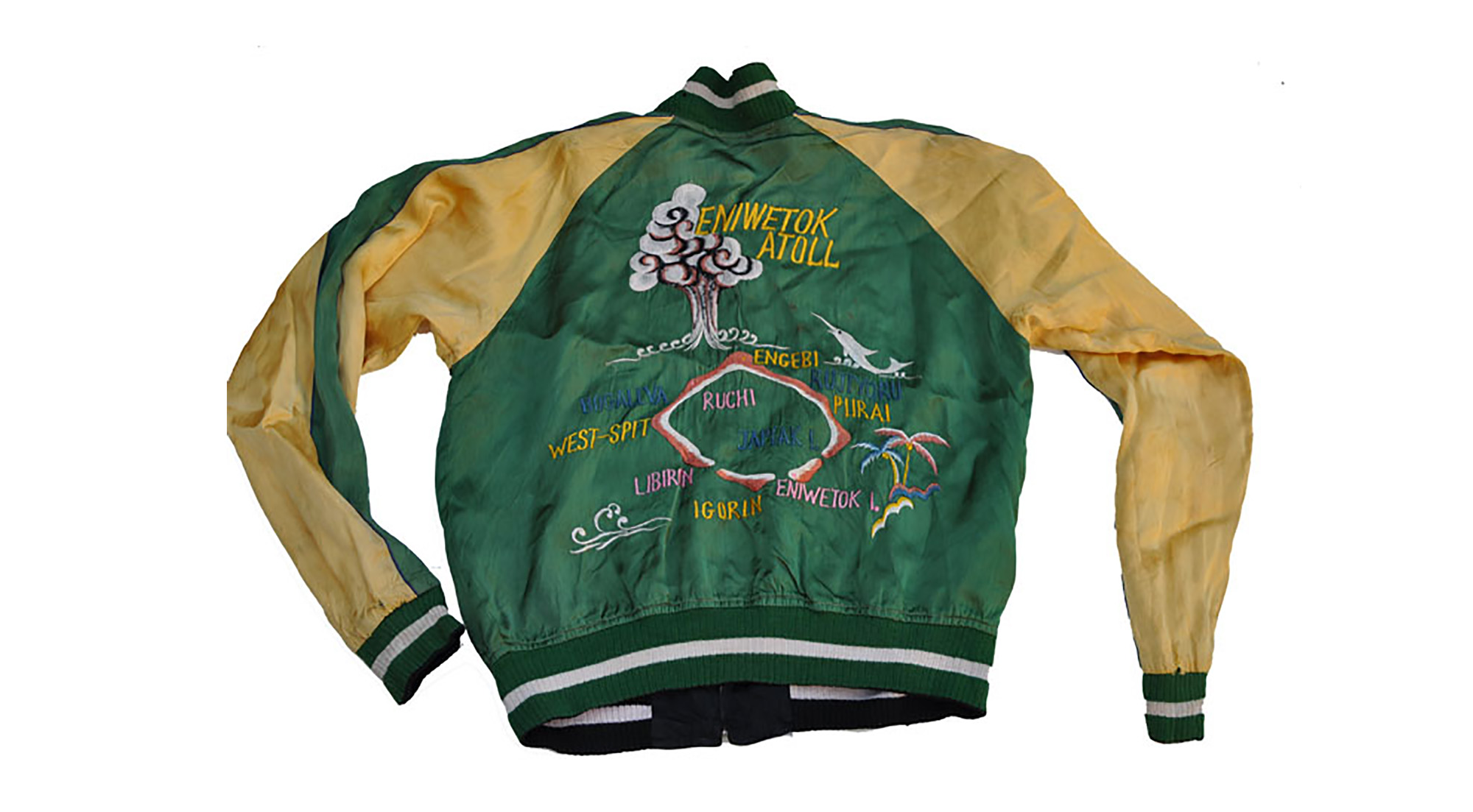
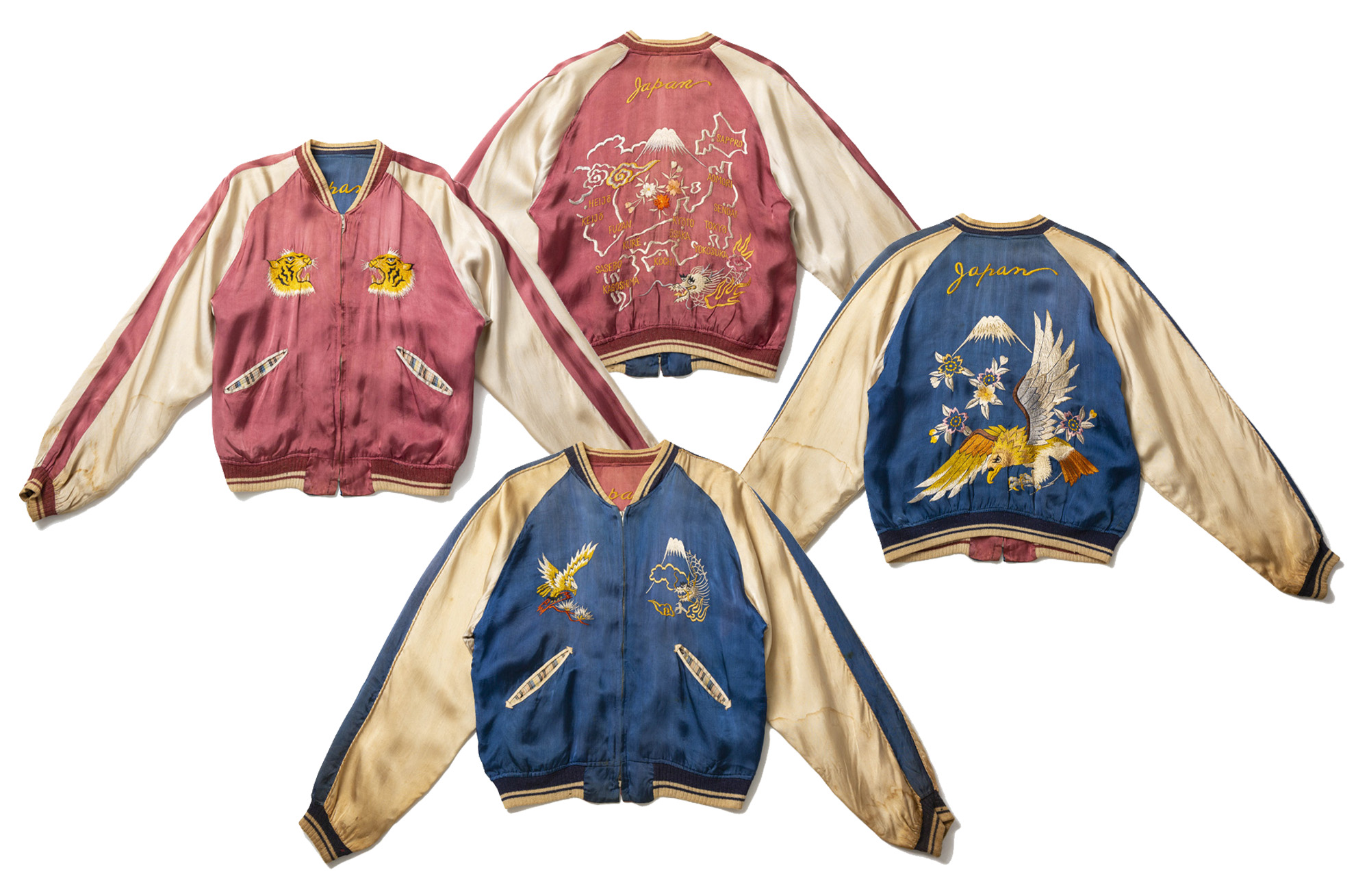
Reversible vintage sukajan from Tailor Toyo
Symbol of Rebellion
Long after soldiers had returned to US soil, Japan became overcome with Ametora (meaning “American tradition”), obsessed and enamoured with all things American. The younger generation were particularly inspired by classic Ivy League fashion, adopting jeans, t-shirts and fisherman sweaters as their own.
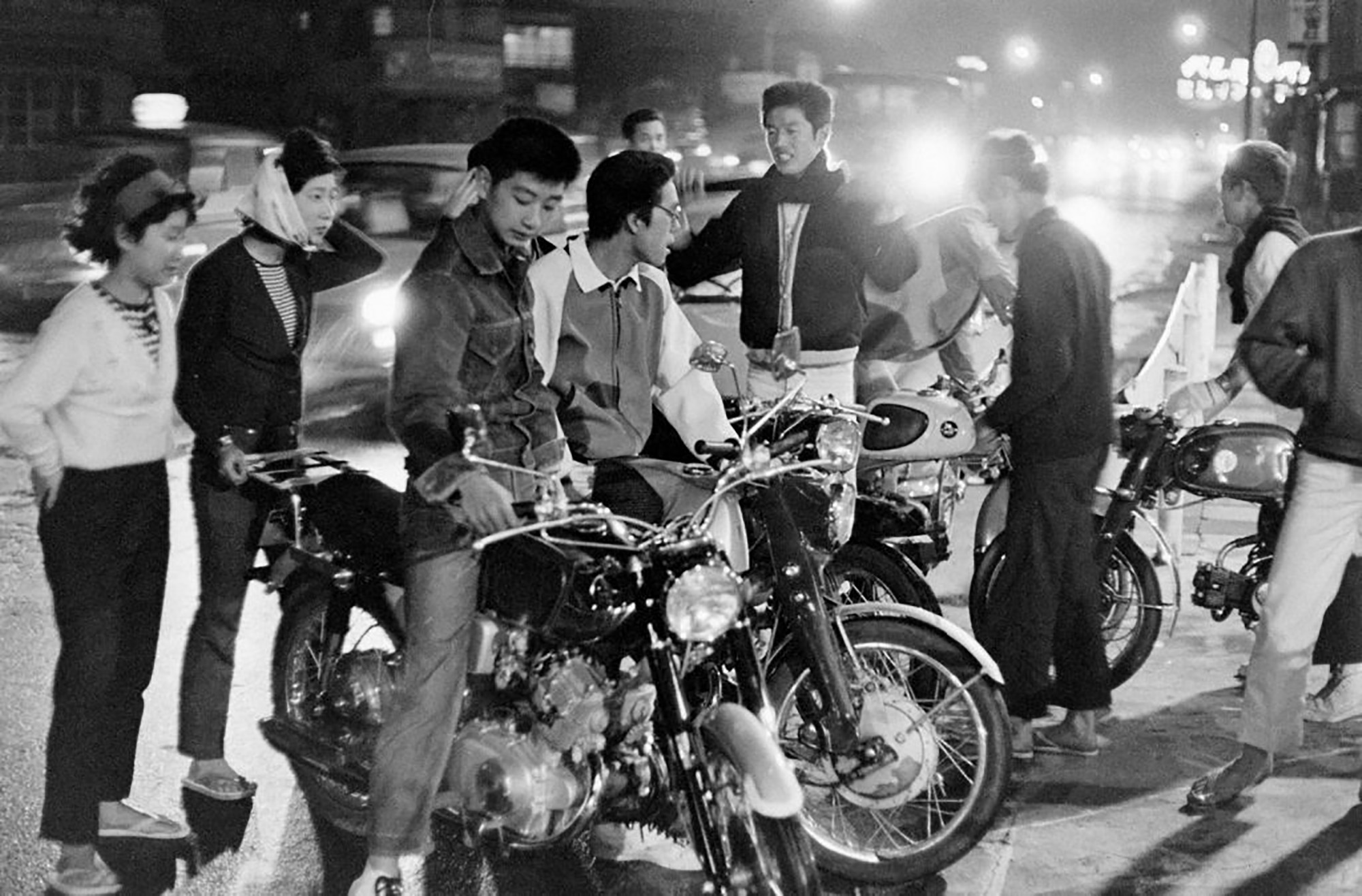
“Portraits of Japanese Youth in Revolt, 1964” – poignant photos by LIFE photographer Michael Rougier
As the style grew in price and popularity, outsider working class youths revolted against the Western-influenced trend. They appropriated the homegrown sukajan as their sartorial calling card; a wearable act of defiance against the mainstream Japanese society, bringing a whole new meaning to the term “statement piece”. Japanese directors further cemented its association with rebellion by portraying members of the Yakuza gang wearing the jackets .
rise to fame
Even if you’ve never been to Japan, you’re sure to have spotted this souvenir jacket everywhere — strutting down a runway, on the big screen, or sported by trend-setting celebs in the tabloids.
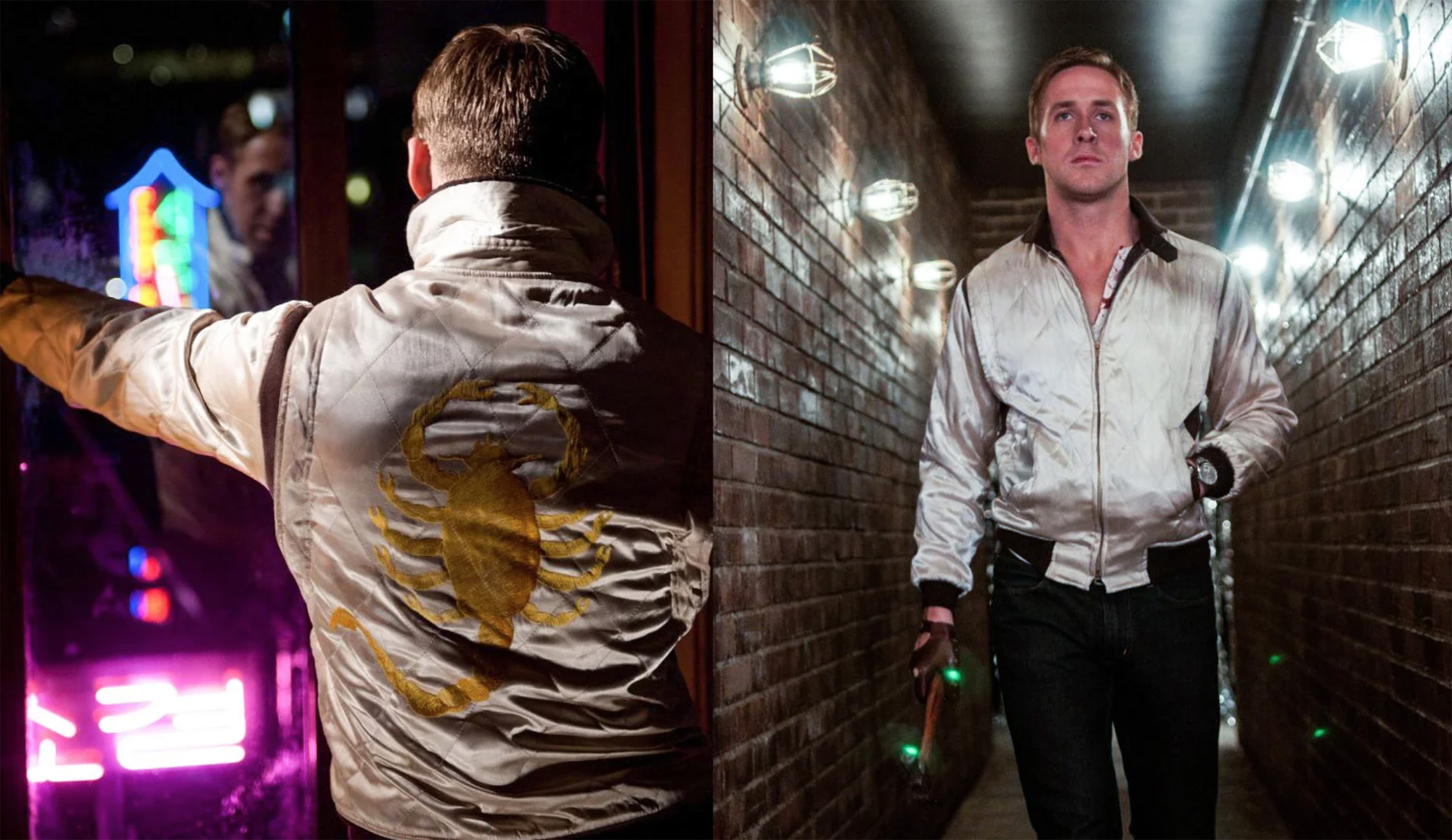
The Iconic silk bomber jacket on Ryan Gosling in Drive via FilmDistrict
A car stuntman by day and getaway driver for mobsters by night, Ryan Gosling’s nameless character in Drive donned a custom-made sukajan that took the costume designer months to perfect. The iconic high-collared souvenir jacket featured a golden scorpion that became symbolic of badassery.
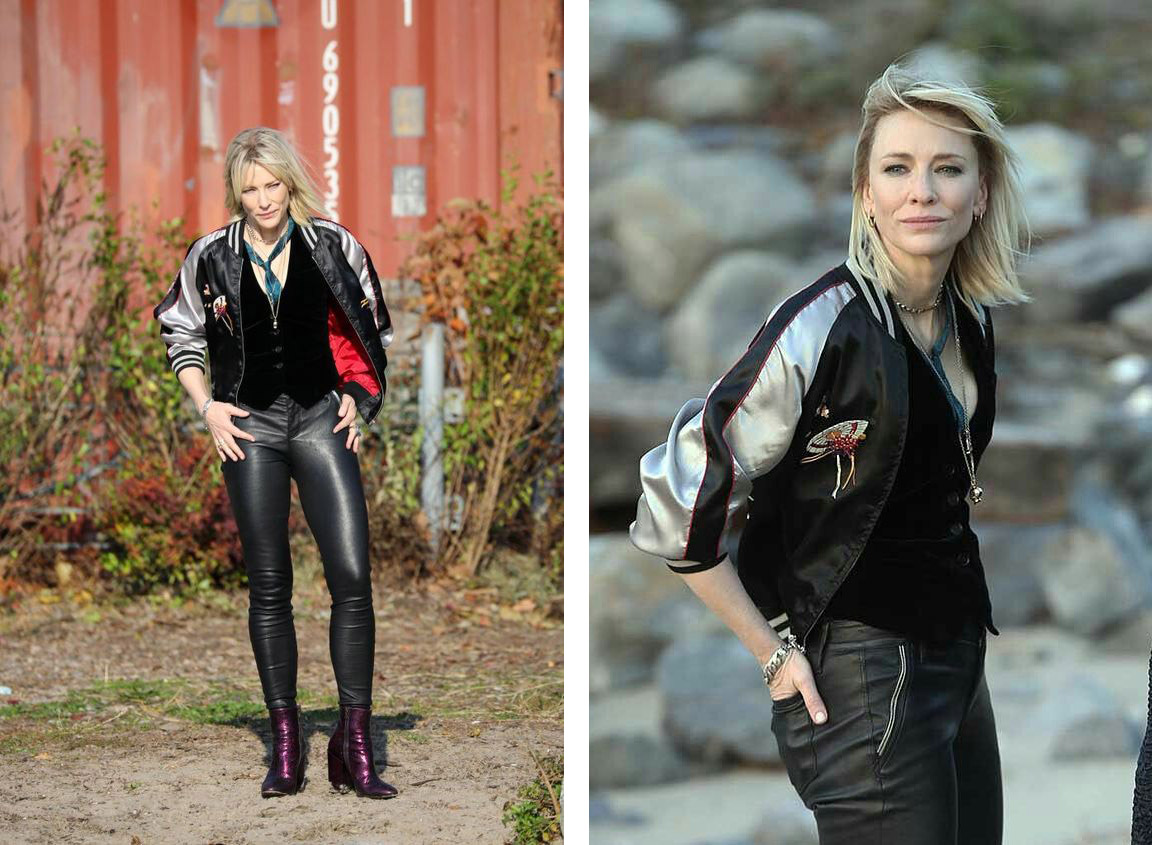
Speaking of badasses, in the female-centric Ocean’s 8, there’s a scene where Cate Blanchett confronts Sandra Bullock’s character wearing a killer satin souvenir jacket. Is it a coincidence that she’s wearing a symbol of rebellion in these particular scene? Probably.
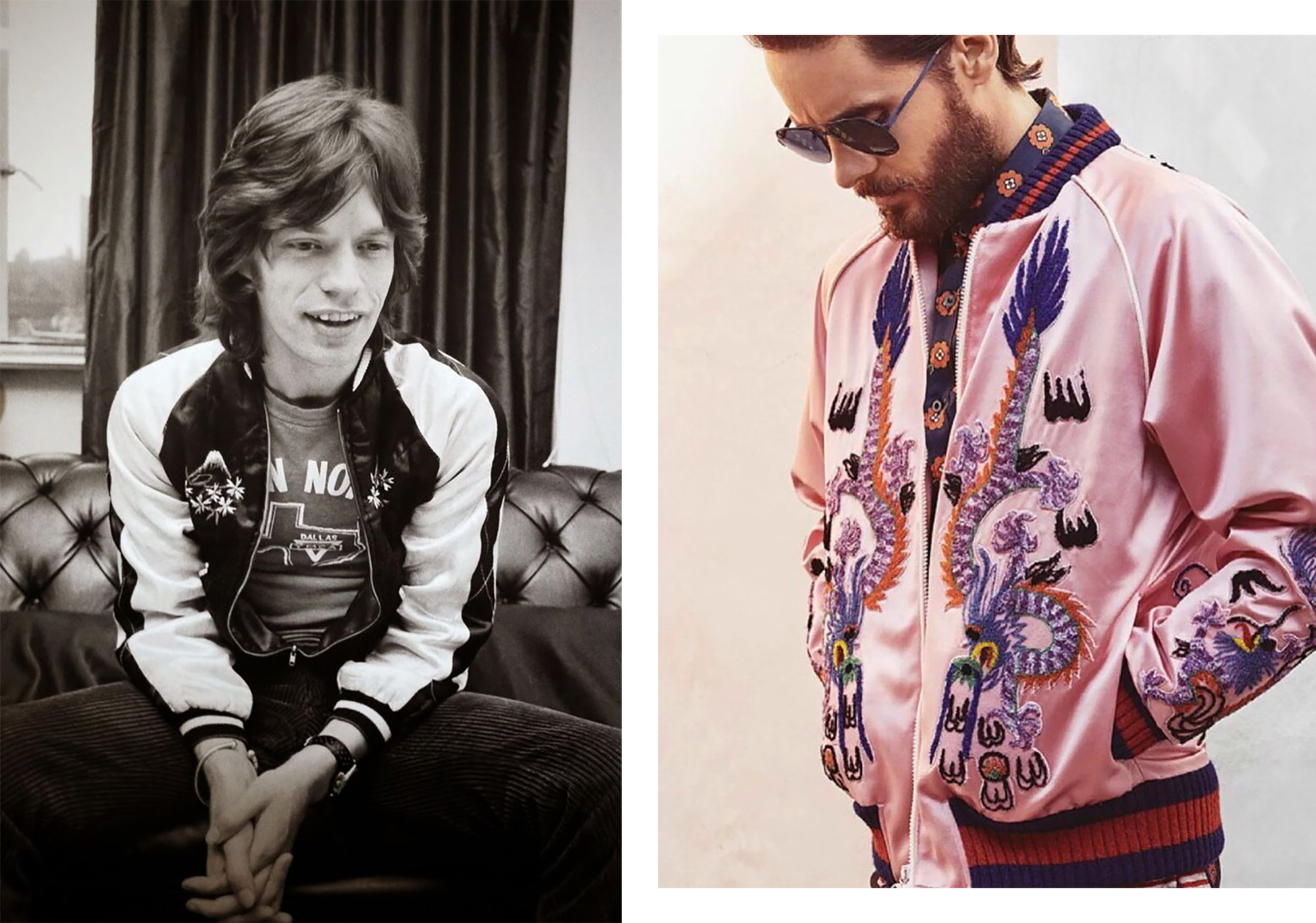
Other than in films, sukajan jackets has been spotted on celebrities from Katy Perry to Jared Leto to Mick Jagger when he was on tour with the Rolling Stones.
Fashion powerhouses like Gucci, Louis Vuitton and Yves Saint Laurent have taken to the runway with collections inspired by sukajan. The distinctive style eventually trickling down to H&M and Zara making souvenir jackets available to the masses.
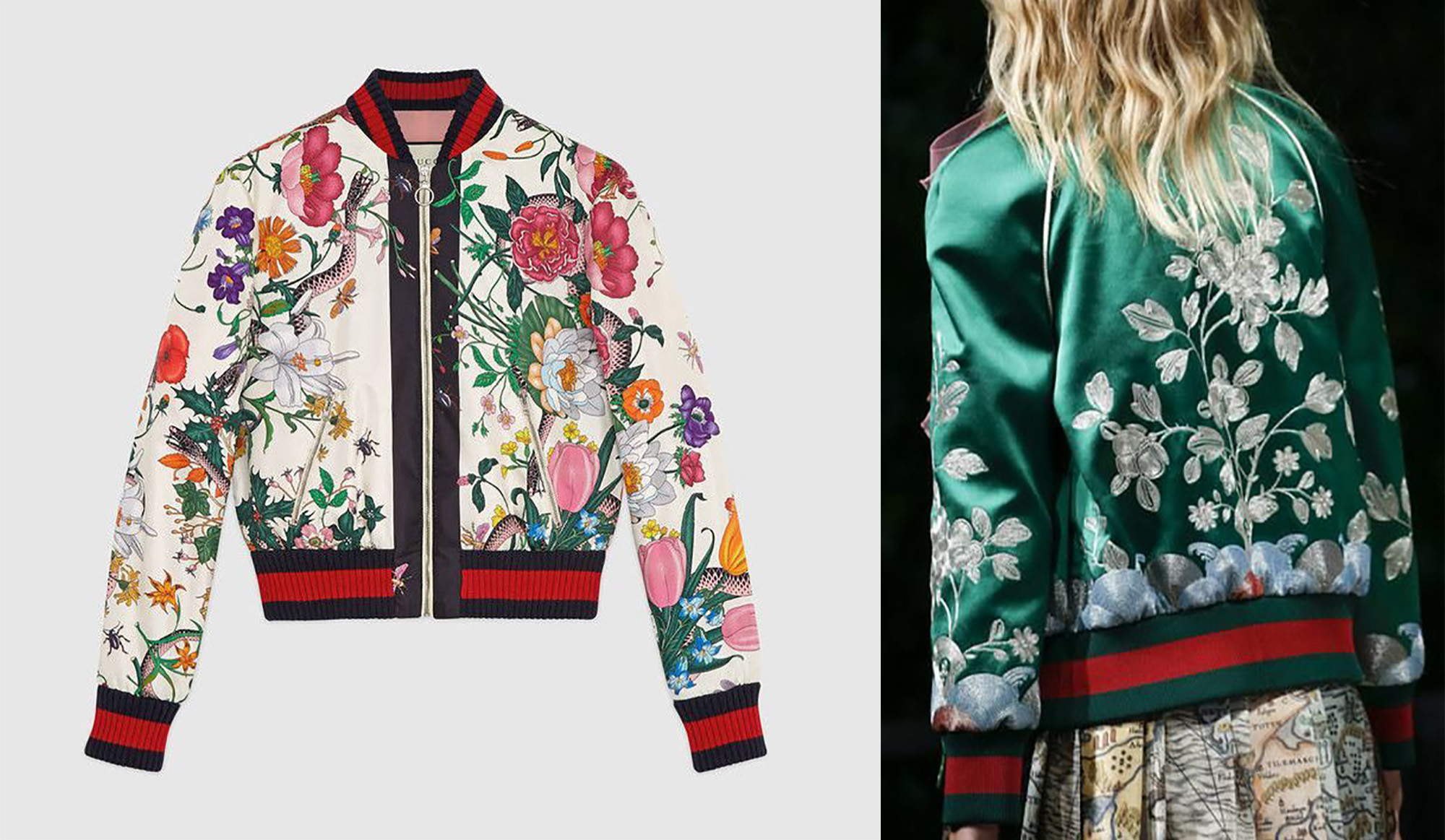
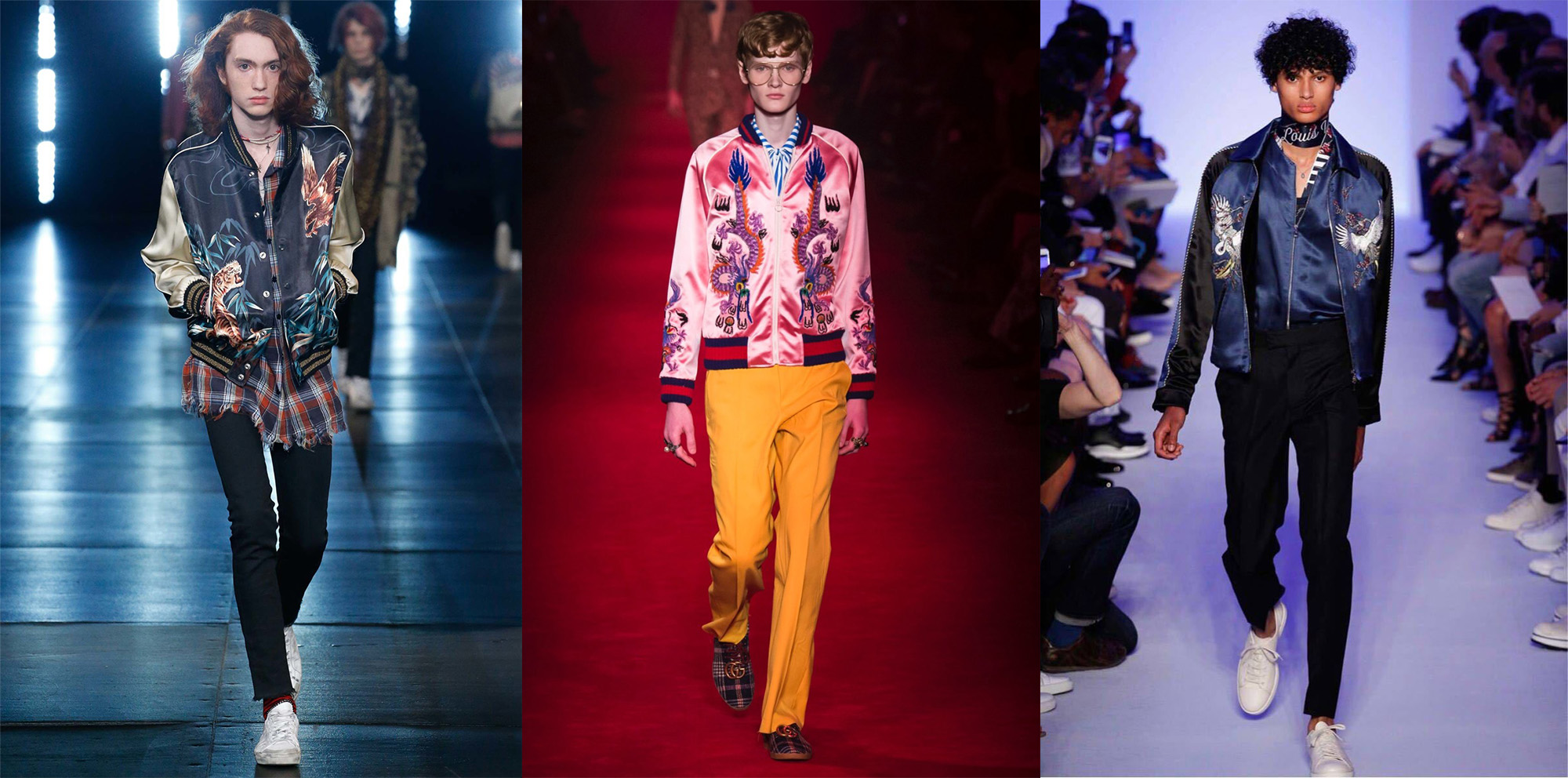
(Above): Gucci floral sujakan (Bottom L – R): Yves Saint Laurent Menswear S/S 2016, Gucci F/W 2016 collection, Louis Vuitton S/S 2016
Tips For Buying + Wearing a Sukajan Jacket:
+ Fit: Sukajan are meant to fit oversized for a cool, slouchy look. Keep in mind that the more embroidery there is, the less stretchy it’ll be so it’s better to err on the larger side. Plus, sukajan (particularly the vintage ones) are generally constructed for more slender Asian body types.
+ Wear and Care: These souvenir jackets are fairly lightweight and don’t provide much warmth unless heavily embroidered. The delicate fabrics are not meant to withstand the harsh elements so don’t save it for a rainy day!
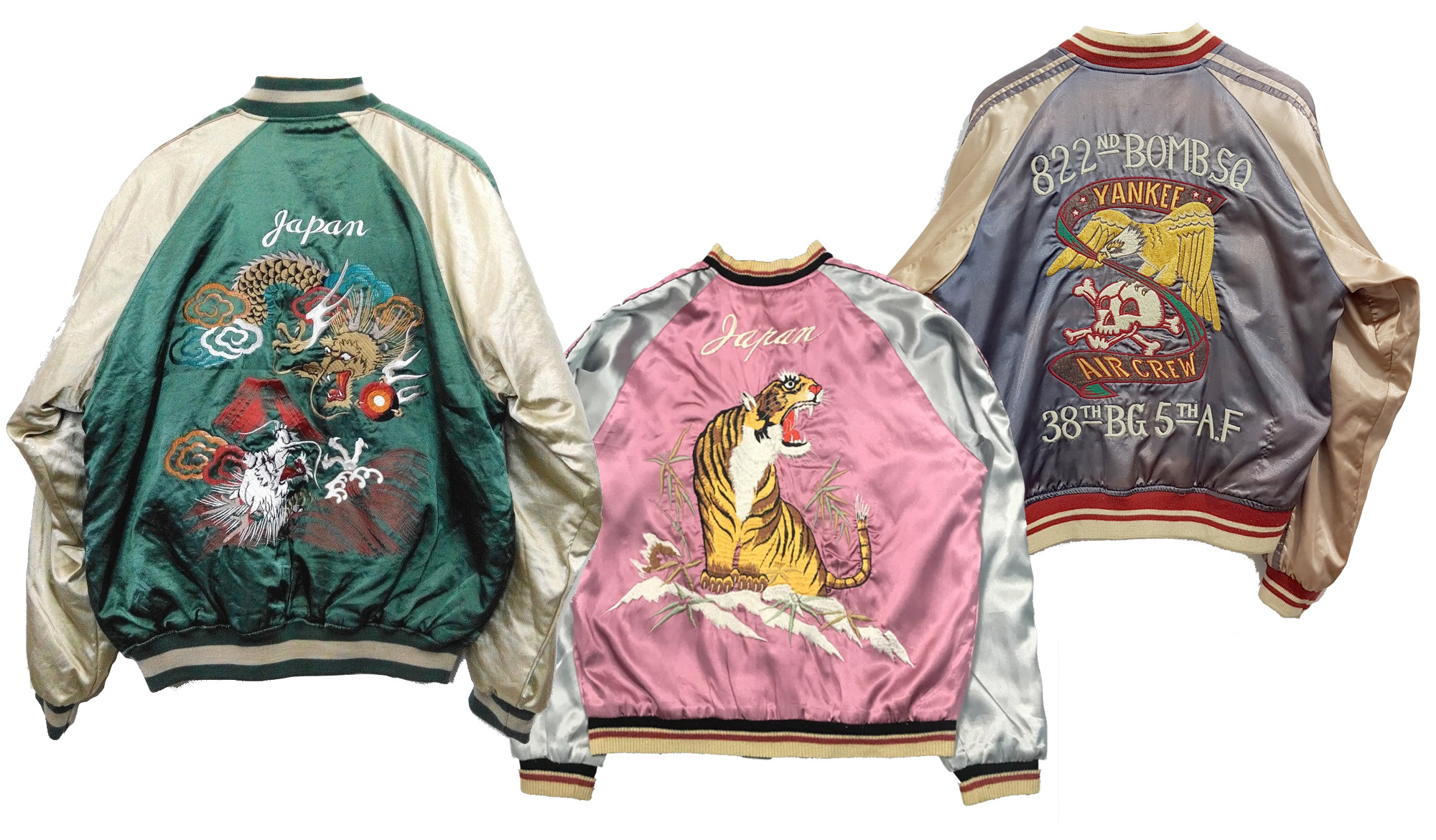
Vintage sukajan jackets by Tailor Toyo
+ Selection Process: There are several factors to consider when choosing a sukajan — vintage or contemporary, price point, intricate or simple embroidery, design elements, colour, etc…Do you want it to serve as a wearable piece of art that will last you a long time or are you looking for a trendy, fast fashion item?
+ Cost: The price for sukajan range from under $200 (fast fashion) to the midrange $400 and under to north of $400. Vintage pieces have an undeniable allure of being one of a kind but they’ll pack a wallop to your wallet. Heavily embroidered souvenir jackets are more costly, requiring a higher level of craftsmanship but are worth every penny.
Where to Buy Sukajan Jacket:
+ Prince Shokai (Tokyo): Where better to find a sukajan in the city it all started: Yokosuka! Prince Shokai has been around for 70 years and you can also customize your own souvenir jacket from a selection of fabric and embroidery samples.
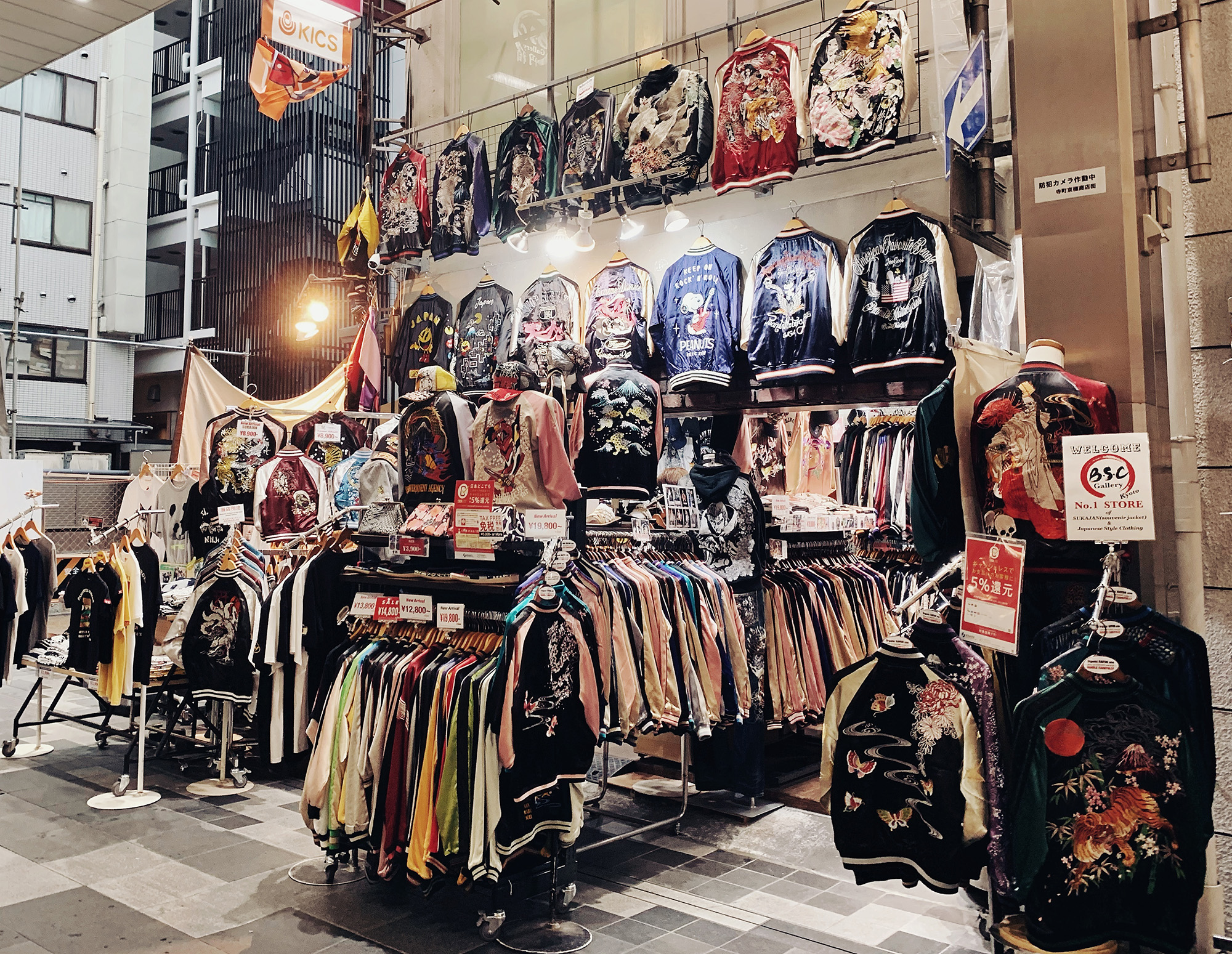
+ BSC Gallery (Kyoto): I had a ball angst-ing over the seemingly endless racks of sukajan at BSC Gallery in Kyoto while the typhoon raged outside. Rifle through limited edition souvenir jackets and one-of-a-kind embroidered pieces that you’ll treasure forever.
+ Japan Lover Me (Online): Browse the vast collection at this popular online store. Turn your dream sukajan into a reality by getting it made-to-order for the ultimate customization.
Considering that I didn’t have a spare inch in my suitcase for any souvenirs (beyond one I could wear) a sukajan jacket was the perfect item to mark my time in Japan. It was worth every Japanese yen that I forked over because it’s a wearable piece of art that I’ll be able to parade around for years to come.
Now that we’ve covered what you’re going to buy in Japan, check out where to eat in Tokyo.
Keep your stalking game strong and follow me @teriaki if you aren’t already!





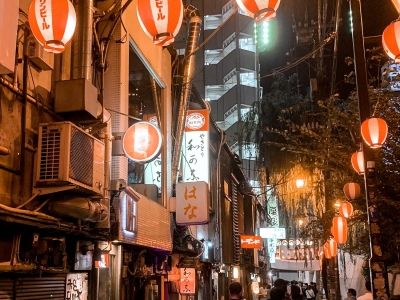
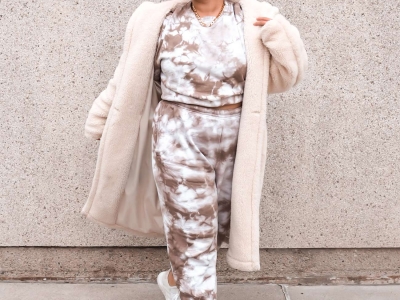

0 Comments